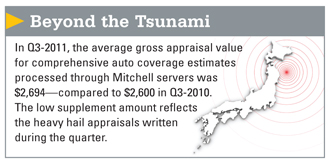 The latest iteration of Mitchell’s Industry Trends Report (ITR) begins with an examination of the impact of the Japanese tsunami on vehicle parts pricing. Greg Horn, ITR editor-in-chief and Mitchell’s vice president of industry relations, alludes to stories of salvage yards hoarding parts, and asks some questions that have weighed heavily on the minds of all involved in the collision parts industry—from repair shops to insurers—since the disaster.
The latest iteration of Mitchell’s Industry Trends Report (ITR) begins with an examination of the impact of the Japanese tsunami on vehicle parts pricing. Greg Horn, ITR editor-in-chief and Mitchell’s vice president of industry relations, alludes to stories of salvage yards hoarding parts, and asks some questions that have weighed heavily on the minds of all involved in the collision parts industry—from repair shops to insurers—since the disaster.
Although many presumed that aftermarket parts usage would increase, and that OEM components would be increasingly difficult to come by, Horn quickly dispels these notions in the opening feature of the 4Q publication. He then leverages the Mitchell Collision Parts Price Index (MCPPI)—a metric similar to the Consumer Price Index (CPI)—to identify trends in parts prices versus inflation and assess the impact of the tsunami on parts selection behavior.
“The tsunami in Japan was incredibly tragic and affected so many,” says Horn. “After having a chance to absorb the dramatic impact on their nation, we wanted to see how it would affect the collision repair community. Our in-depth analysis using the MCPPI indicates the tsunami had little net impact on parts pricing. Isolating the Japanese vehicle parts index and breaking out the subset of Japanese make by part type shows that the Japanese vehicle index mirrors broader market trends. In the aggregate, parts prices increased, even in a year where inflation has slowed to the lowest rate since we began measuring the index.
Recommended For You
Want to continue reading?
Become a Free PropertyCasualty360 Digital Reader
Your access to unlimited PropertyCasualty360 content isn’t changing.
Once you are an ALM digital member, you’ll receive:
- Breaking insurance news and analysis, on-site and via our newsletters and custom alerts
- Weekly Insurance Speak podcast featuring exclusive interviews with industry leaders
- Educational webcasts, white papers, and ebooks from industry thought leaders
- Critical converage of the employee benefits and financial advisory markets on our other ALM sites, BenefitsPRO and ThinkAdvisor
Already have an account? Sign In Now
© Touchpoint Markets, All Rights Reserved. Request academic re-use from www.copyright.com. All other uses, submit a request to [email protected]. For more inforrmation visit Asset & Logo Licensing.







